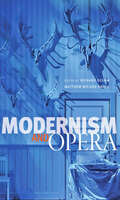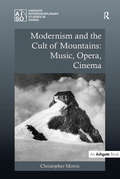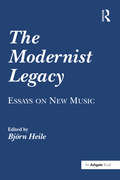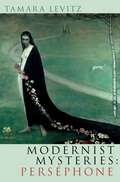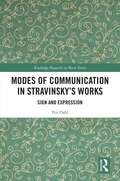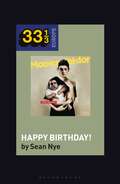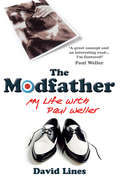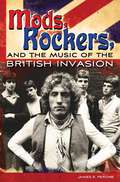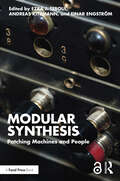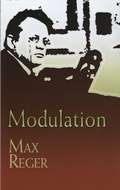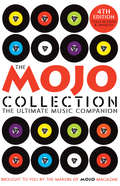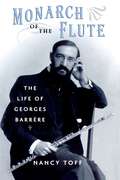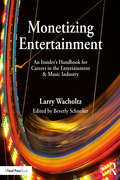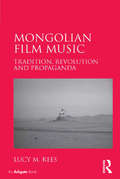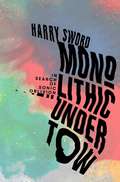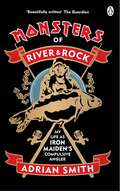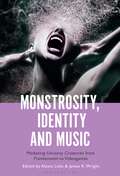- Table View
- List View
Modernism and Opera (Hopkins Studies in Modernism)
by Richard Begam Matthew Wilson SmithAt first glance, modernism and opera may seem like strange bedfellows;¢;‚¬;€?the former hostile to sentiment, the latter wearing its heart on its sleeve. And yet these apparent opposites attract: many operas are aesthetically avant-garde, politically subversive, and socially transgressive. From the proto-modernist strains of Richard Wagner;€™s Parsifal through the twenty-first-century modernism of Kaija Saariaho;€™s L;€™amour de loin, the duet between modernism and opera, at turns harmonious and dissonant, has been one of the central artistic events of modernity. Despite this centrality, scholars of modernist literature only rarely venture into opera, and music scholars generally return the favor by leaving literature to one side. But opera, that grand cauldron of the arts, demands that scholars, too, share the stage with one another.In Modernism and Opera, Richard Begam and Matthew Wilson Smith bring together musicologists, literary critics, and theater scholars for the first time in a mutual endeavor to trace certain key moments in the history of modernism and opera. This innovative volume includes essays from some of the most notable scholars in their fields and covers works as diverse as Debussy;€™s Pell;©as et M;©lisande, Bart;³k;€™s Bluebeard;€™s Castle, Berg;€™s Wozzeck, Jan;¡cek;€™s Makropulos Case, Thomson;€™s Four Saints in Three Acts, Strauss;€™s Arabella, Schoenberg;€™s Moses und Aron, Stravinsky;€™s The Rake;€™s Progress, Britten;€™s Gloriana, and Messiaen;€™s Saint Fran;§ois d;€™Assise. A collaborative study of the ultimate collaborative art form, Modernism and Opera reveals how modernism and opera illuminate each other and, more generally, the culture of the twentieth century. It also addresses a number of issues crucial for understanding the relation between modernism and opera, focusing in particular on intermediality (how modernism integrates music, literature, and drama into opera) and anti-theatricality (how opera responds to modernism;€™s apparent antipathy to theatricality). This captivating book;¢;‚¬;€?the first of its kind;¢;‚¬;€?will appeal to scholars of literature, music, theater, and modernity as well as to sophisticated opera lovers everywhere.
Modernism and the Cult of Mountains: Music, Opera, Cinema (Ashgate Interdisciplinary Studies in Opera)
by Christopher MorrisAdopting and transforming the Romantic fascination with mountains, modernism in the German-speaking lands claimed the Alps as a space both of resistance and of escape. This new 'cult of mountains' reacted to the symptoms and alienating forces associated with modern culture, defining and reinforcing models of subjectivity based on renewed wholeness and an aggressive attitude to physical and mental health. The arts were critical to this project, none more so than music, which occupied a similar space in Austro-German culture: autonomous, pure, sublime. In Modernism and the Cult of Mountains opera serves as a nexus, shedding light on the circulation of contesting ideas about politics, nature, technology and aesthetics. Morris investigates operatic representations of the high mountains in German modernism, showing how the liminal quality of the landscape forms the backdrop for opera's reflexive engagement with the identity and limits of its constituent media, not least music. This operatic reflexivity, in which the very question of music's identity is repeatedly restaged, invites consideration of musical encounters with mountains in other genres, and Morris shows how these issues resonate in Strauss's Alpine Symphony and in the Bergfilm (mountain film). By using music and the ideology of mountains to illuminate aspects of each other, Morris makes an original and valuable contribution to the critical study of modernism.
Modernism and the Cult of Mountains: Music, Opera, Cinema (Ashgate Interdisciplinary Studies in Opera)
by Christopher MorrisAdopting and transforming the Romantic fascination with mountains, modernism in the German-speaking lands claimed the Alps as a space both of resistance and of escape. This new 'cult of mountains' reacted to the symptoms and alienating forces associated with modern culture, defining and reinforcing models of subjectivity based on renewed wholeness and an aggressive attitude to physical and mental health. The arts were critical to this project, none more so than music, which occupied a similar space in Austro-German culture: autonomous, pure, sublime. In Modernism and the Cult of Mountains opera serves as a nexus, shedding light on the circulation of contesting ideas about politics, nature, technology and aesthetics. Morris investigates operatic representations of the high mountains in German modernism, showing how the liminal quality of the landscape forms the backdrop for opera's reflexive engagement with the identity and limits of its constituent media, not least music. This operatic reflexivity, in which the very question of music's identity is repeatedly restaged, invites consideration of musical encounters with mountains in other genres, and Morris shows how these issues resonate in Strauss's Alpine Symphony and in the Bergfilm (mountain film). By using music and the ideology of mountains to illuminate aspects of each other, Morris makes an original and valuable contribution to the critical study of modernism.
The Modernist Legacy: Essays on New Music
by Bj HeileThis collection of essays offers a historical reappraisal of what musical modernism was, and what its potential for the present and future could be. It thus moves away from the binary oppositions that have beset twentieth-century music studies in the past, such as those between modernism and postmodernism, between conceptions of musical autonomy and of cultural contingency and between formalist-analytical and cultural-historical approaches. Focussing particularly on music from the 1970s to the 1990s, the volume assembles approaches from different perspectives to new music with a particular emphasis on a critical reassessment of the meaning and function of the legacy of musical modernism. The authors include scholars, musicologists and composers who combine culturally, socially, historically and aesthetically oriented approaches with analytical methods in imaginative ways.
The Modernist Legacy: Essays on New Music
by Björn HeileThis collection of essays offers a historical reappraisal of what musical modernism was, and what its potential for the present and future could be. It thus moves away from the binary oppositions that have beset twentieth-century music studies in the past, such as those between modernism and postmodernism, between conceptions of musical autonomy and of cultural contingency and between formalist-analytical and cultural-historical approaches. Focussing particularly on music from the 1970s to the 1990s, the volume assembles approaches from different perspectives to new music with a particular emphasis on a critical reassessment of the meaning and function of the legacy of musical modernism. The authors include scholars, musicologists and composers who combine culturally, socially, historically and aesthetically oriented approaches with analytical methods in imaginative ways.
Modernist Mysteries: Persephone
by Tamara LevitzModernist Mysteries: Perséphone is a landmark study that will move the field of musicology in important new directions. The book presents a microhistorical analysis of the premiere of the melodrama Perséphone at the Paris Opera on April 30th, 1934, engaging with the collaborative, transnational nature of the production. Author Tamara Levitz demonstrates how these collaborators-- Igor Stravinsky, André Gide, Jacques Copeau, and Ida Rubinstein, among others-used the myth of Persephone to perform and articulate their most deeply held beliefs about four topics significant to modernism: religion, sexuality, death, and historical memory in art. In investigating the aesthetic and political consequences of the artists' diverging perspectives, and the fall-out of their titanic clash on the theater stage, Levitz dismantles myths about neoclassicism as a musical style. The result is a revisionary account of modernism in music in the 1930s. As a result of its focus on the collaborative performance, this book differs from traditional accounts of musical modernism and neoclassicism in several ways. First and foremost, it centers on the performance of modernism, highlighting the theatrical, performative, and sensual. Levitz places Christianity in the center of the discussion, and questions the national distinctions common in modernist research by involving a transnational team of collaborators. She further breaks new ground in shifting the focus from "history" to "memory" by emphasizing the commemorative nature of neoclassic listening rituals over the historicist stylization of its scores, and contends that modernists captured on stage and in philosophical argument their simultaneous need and inability to mourn the past. The book as a whole counters the common criticism that neoclassicism was a "reactionary" musical style by suggesting a more pluralistic, ambivalent, and sometimes even progressive politics, and reconnects musical neoclassicism with a queer classicist tradition extending from Winckelmann through Walter Pater to Gide. Modernist Mysteries concludes that 1930s modernists understood neoclassicism not as formalist compositional approaches but rather as a vitalist art haunted by ghosts of the past and promissory visions of the future.
Modes of Communication in Stravinsky’s Works: Sign and Expression (Routledge Research in Music)
by Per DahlIgor Stravinsky left behind a complex heritage of music and ideas. There are many examples of discrepancies between his literate statements about music and musicians and his musical compositions and activity. Per Dahl presents a model of communication that unveils a clear and logical understanding of Stravinsky's heritage, based on the extant material available. From this, Dahl argues the case for Stravinsky’s music and his ideas as separate entities, representing different modes of communication. As well as describing a triangular model of communication, based on a tilted and extended version of Ogden's triangle, Dahl presents an empirical investigation of Stravinsky's vocabulary of signs and expressions in his published scores - his communicative mode towards musicians. In addition to simple statistics, Dahl compares the notation practice in the composer’s different stylistic epochs as well as his writing for different sizes of ensembles. Dahl also considers Stravinsky’s performances and recordings as modes of communication to investigate whether the multi-layered model can soften the discrepancies between Stravinsky the literate and Stravinsky the musician.
Modes of Communication in Stravinsky’s Works: Sign and Expression (Routledge Research in Music)
by Per DahlIgor Stravinsky left behind a complex heritage of music and ideas. There are many examples of discrepancies between his literate statements about music and musicians and his musical compositions and activity. Per Dahl presents a model of communication that unveils a clear and logical understanding of Stravinsky's heritage, based on the extant material available. From this, Dahl argues the case for Stravinsky’s music and his ideas as separate entities, representing different modes of communication. As well as describing a triangular model of communication, based on a tilted and extended version of Ogden's triangle, Dahl presents an empirical investigation of Stravinsky's vocabulary of signs and expressions in his published scores - his communicative mode towards musicians. In addition to simple statistics, Dahl compares the notation practice in the composer’s different stylistic epochs as well as his writing for different sizes of ensembles. Dahl also considers Stravinsky’s performances and recordings as modes of communication to investigate whether the multi-layered model can soften the discrepancies between Stravinsky the literate and Stravinsky the musician.
Modeselektor’s Happy Birthday! (33 1/3 Europe)
by Sean NyeModeselektor, the Berlin electronic duo consisting of Gernot Bronsert and Sebastian Szary, released Happy Birthday! in 2007, an album that mixed emotion, humor, and party excess. Through this album, this book presents a unique window into the histories of Berlin techno, European rave culture, and electronic music. By emphasizing Happy Birthday! as a network of collabs, genres, and insider winks, it highlights key features in Modeselektor's career: above all, the beginnings of Moderat, the famous project between Modeselektor and Apparat, as well as the connections to groups and artists as diverse as Thom Yorke, Ellen Allien, Paul St. Hilaire, Otto von Schirach, Scooter, and Jones & Stephenson.33 1/3 Global, a series related to but independent from 33 1/3, takes the format of the original series of short, music-based books and brings the focus to music throughout the world. With initial volumes focusing on Japanese and Brazilian music, the series will also include volumes on the popular music of Australia/Oceania, Europe, Africa, the Middle East, and more.
Modeselektor’s Happy Birthday! (33 1/3 Europe)
by Sean NyeModeselektor, the Berlin electronic duo consisting of Gernot Bronsert and Sebastian Szary, released Happy Birthday! in 2007, an album that mixed emotion, humor, and party excess. Through this album, this book presents a unique window into the histories of Berlin techno, European rave culture, and electronic music. By emphasizing Happy Birthday! as a network of collabs, genres, and insider winks, it highlights key features in Modeselektor's career: above all, the beginnings of Moderat, the famous project between Modeselektor and Apparat, as well as the connections to groups and artists as diverse as Thom Yorke, Ellen Allien, Paul St. Hilaire, Otto von Schirach, Scooter, and Jones & Stephenson.33 1/3 Global, a series related to but independent from 33 1/3, takes the format of the original series of short, music-based books and brings the focus to music throughout the world. With initial volumes focusing on Japanese and Brazilian music, the series will also include volumes on the popular music of Australia/Oceania, Europe, Africa, the Middle East, and more.
The Modfather: My Life with Paul Weller
by David LinesWhen David Lines first heard This is the Modern World by The Jam, it sparked off a love affair that continues to this day. Paul Weller became the blueprint for David's life, and he followed his music and his style with the fervour of a truly devoted fan - to the bemusement of his long-suffering family. At once disarmingly candid and hilariously funny, this is the story of what it means to have a hero, its pleasures and pitfalls. Illustrating his memoir with landmark songs from The Jam and The Style Council, David maps out the occasionally bizarre events in the life of an obsessive fan and wannabe writer.From Player's Navy Cut to Gitanes, boating blazers to cashmere sweaters, The Modfather is about acquiring style, finding substance and living life with Paul Weller.
Mods, Rockers, and the Music of the British Invasion (Non-ser.)
by James E. PeroneMusical floodgates were opened after the Beatles' first appearance on The Ed Sullivan Show on February 9, 1964. Suddenly, the U.S. record charts, radio, and television were overrun with British rock and pop musicians. Although this British Invasion was the first exposure many Americans had to popular music from the United Kingdom, British pop — and more specifically British rock and roll — had been developing since the middle of the 1950s. Author James Perone here chronicles the development of British rock, from the 1950s imitators of Elvis Presley and other American rockabilly artists, to the new blends of rockabilly, R&B, Motown, and electric blues that defined the British Invasion as we recognize it today. Die-hard fans of the Beatles, the Who, and the Kinks will all want a copy, as will anyone interested in the 1960s more generally.May 1964 saw major gang-style battles break out in British resort communities between the Mods and the Rockers. The tensions between the two groups had been developing for several years, with each group claiming their own sense of culture and style. The Mods wore designer clothing, rode Vespa motor scooters, and shared an affinity for black American soul music, while the Rockers favored powerful motorcycles, greased-back hair, and 1950s American rock and roll. It was within this context that the sounds of the British Invasion developed.Mods, Rockers, and the Music of the British Invasion chronicles the development of British rock through the iconic artists who inspired the movement, as well as through the bands who later found incredible success overseas. In addition to analyzing the music in the context of the British youth culture of the early 1960s, Perone analyzes the reasons that the British bands came to so thoroughly dominate the record charts and airwaves in the United States.The contributions of Cliff Richard, Billy Fury, Johnny Kidd and the Pirates, Tommy Steele, the Tornados, Tony Sheridan, Blues Incorporated, and others to the development of British rock and roll are examined, as are the contributions and commercial and artistic impact of major British Invasion artists such as the Beatles, the Rolling Stones, the Dave Clark Five, the Yardbirds, Manfred Mann, the Who, the Kinks, and others. After investigating these groups and their influences upon one another, Perone concludes by examining the commercial and stylistic impact British rock musicians had on the American music of the time.
Modular Synthesis: Patching Machines and People
by Ezra J. Teboul Andreas Kitzmann Einar EngströmModular Synthesis: Patching Machines and People brings together scholars, artists, composers, and musical instrument designers in an exploration of modular synthesis, an unusually multifaceted musical instrument that opens up many avenues for exploration and insight, particularly with respect to technological use, practice, and resistance.Through historical, technical, social, aesthetic, and other perspectives, this volume offers a collective reflection on the powerful connections between technology, creativity, culture, and personal agency. Ultimately, this collection is about creativity in a technoscientific world and speaks to issues fundamental to our everyday lives and experiences, by providing insights into the complex relationships between content creators, the technologies they use, and the individuals and communities who design and engage with them.With chapters covering VCV Rack, modular synthesis, instrument design, and the histories of synthesizer technology, as well as interviews with Dave Rossum, Corry Banks, Meng Qi, and Dani Dobkin, among others, Modular Synthesis is recommended reading for advanced undergraduates, researchers, and practitioners of electronic music and music technology. Chapter 3 of this book is freely available as a downloadable Open Access PDF at http://www.taylorfrancis.com under a Creative Commons Attribution-Non Commercial-No Derivatives (CC-BY-NC-ND) 4.0 license.
Modular Synthesis: Patching Machines and People
by Ezra J. Teboul Andreas Kitzmann Einar EngströmModular Synthesis: Patching Machines and People brings together scholars, artists, composers, and musical instrument designers in an exploration of modular synthesis, an unusually multifaceted musical instrument that opens up many avenues for exploration and insight, particularly with respect to technological use, practice, and resistance.Through historical, technical, social, aesthetic, and other perspectives, this volume offers a collective reflection on the powerful connections between technology, creativity, culture, and personal agency. Ultimately, this collection is about creativity in a technoscientific world and speaks to issues fundamental to our everyday lives and experiences, by providing insights into the complex relationships between content creators, the technologies they use, and the individuals and communities who design and engage with them.With chapters covering VCV Rack, modular synthesis, instrument design, and the histories of synthesizer technology, as well as interviews with Dave Rossum, Corry Banks, Meng Qi, and Dani Dobkin, among others, Modular Synthesis is recommended reading for advanced undergraduates, researchers, and practitioners of electronic music and music technology. Chapter 3 of this book is freely available as a downloadable Open Access PDF at http://www.taylorfrancis.com under a Creative Commons Attribution-Non Commercial-No Derivatives (CC-BY-NC-ND) 4.0 license.
Modulation: Music Book Index
by Max RegerIn addition to his international renown as a teacher, conductor, and pianist, Reger wrote more than 1,000 works in virtually every musical genre. Many scholars and musicians credit him with emancipating dissonance to a level that assisted Schoenberg's development of serialism in the 1920s. Reger's influence extends to other 20th-century composers, including Béla Bártok, Alban Berg, Arthur Honegger, Paul Hindemith, and Sergei Prokofiev.Modulation — the change from one key to another — is a subject of critical importance to performers and composers in their study of harmony. Reger wrote this concise guide to modulation while teaching composition at Leipzig Conservatory, and the work continues to provide valuable insights and instruction for musicians at all levels. This new edition features newly engraved musical examples.
The Mojo Collection: 4th Edition
by Various Mojo MagazineThe greatest albums of all time . . . and how they happened. Organised chronologically and spanning seven decades, The MOJO Collection presents an authoritative and engaging guide to the history of the pop album via hundreds of long-playing masterpieces, from the much-loved to the little known. From The Beatles to The Verve, from Duke Ellington to King Tubby and from Peggy Lee to Sly Stone, hundreds of albums are covered in detail with chart histories, full track and personnel listings and further listening suggestions. There's also exhaustive coverage of the soundtrack and hit collections that every home should have. Like all collections, there are records you listen to constantly, albums you've forgotten, albums you hardly play, albums you love guiltily and albums you thought you were alone in treasuring, proving The MOJO Collection to be an essential purchase for those who love and live music.
Monarch of the Flute: The Life of Georges Barrère
by Nancy ToffGeorges Barrère (1876-1944) holds a preeminent place in the history of American flute playing. Best known for two of the landmark works that were written for him--the Poem of Charles Tomlinson Griffes and Density 21.5 by Edgard Varèse--he was the most prominent early exemplar of the Paris Conservatoire tradition in the United States and set a new standard for American woodwind performance. Barrère's story is a musical tale of two cities, and this book uses his life as a window onto musical life in Belle Epoque Paris and twentieth-century New York. Recurrent themes are the interactions of composers and performers; the promotion of new music; the management, personnel, and repertoire of symphony orchestras; the economic and social status of the orchestral and solo musician, including the increasing power of musicians' unions; the role of patronage, particularly women patrons; and the growth of chamber music as a professional performance medium. A student of Paul Taffanel at the Paris Conservatoire, by age eighteen Barrère played in the premiere of Debussy's Prelude to the Afternoon of a Faun. He went on to become solo flutist of the Concerts Colonne and to found the Sociètè Moderne d'Instruments á Vent, a pioneering woodwind ensemble that premiered sixty-one works by forty composers in its first ten years. Invited by Walter Damrosch to become principal flute of the New York Symphony in 1905, he founded the woodwind department at the Institute of Musical Art (later Juilliard). His many ensembles toured the United States, building new audiences for chamber music and promoting French repertoire as well as new American music. Toff narrates Barrère's relationships with the finest musicians and artists of his day, among them Isadora Duncan, Yvette Guilbert, André Caplet, Paul Hindemith, Albert Roussel, Wallingford Riegger, and Henry Brant. The appendices of the book, which list Barrère's 170 premieres and the 50 works dedicated to him, are a resource for a new generation of performers. Based on extensive archival research and oral histories in both France and the United States, this is the first biography of Barrère.
Monarch of the Flute: The Life of Georges Barrère
by Nancy ToffGeorges Barrère (1876-1944) holds a preeminent place in the history of American flute playing. Best known for two of the landmark works that were written for him--the Poem of Charles Tomlinson Griffes and Density 21.5 by Edgard Varèse--he was the most prominent early exemplar of the Paris Conservatoire tradition in the United States and set a new standard for American woodwind performance. Barrère's story is a musical tale of two cities, and this book uses his life as a window onto musical life in Belle Epoque Paris and twentieth-century New York. Recurrent themes are the interactions of composers and performers; the promotion of new music; the management, personnel, and repertoire of symphony orchestras; the economic and social status of the orchestral and solo musician, including the increasing power of musicians' unions; the role of patronage, particularly women patrons; and the growth of chamber music as a professional performance medium. A student of Paul Taffanel at the Paris Conservatoire, by age eighteen Barrère played in the premiere of Debussy's Prelude to the Afternoon of a Faun. He went on to become solo flutist of the Concerts Colonne and to found the Sociètè Moderne d'Instruments á Vent, a pioneering woodwind ensemble that premiered sixty-one works by forty composers in its first ten years. Invited by Walter Damrosch to become principal flute of the New York Symphony in 1905, he founded the woodwind department at the Institute of Musical Art (later Juilliard). His many ensembles toured the United States, building new audiences for chamber music and promoting French repertoire as well as new American music. Toff narrates Barrère's relationships with the finest musicians and artists of his day, among them Isadora Duncan, Yvette Guilbert, André Caplet, Paul Hindemith, Albert Roussel, Wallingford Riegger, and Henry Brant. The appendices of the book, which list Barrère's 170 premieres and the 50 works dedicated to him, are a resource for a new generation of performers. Based on extensive archival research and oral histories in both France and the United States, this is the first biography of Barrère.
Monetizing Entertainment: An Insider's Handbook for Careers in the Entertainment & Music Industry
by Larry WacholtzMonetizing Entertainment: An Insider's Handbook for Careers in the Entertainment & Music Industry offers a thorough, guided exploration of the current state of the industry, with an emphasis on trends in copyright, digital streaming, and practical advice for developing a career as an artist, technician, or industry executive. This book investigates a variety of topics within the entertainment and music industry, ranging from traditional and emerging business models to intellectual property rights to the creative destruction happening currently. The book strategically outlines the existing gaps that make being successful as an artist a dynamic interaction between creativity and business. This book includes the following: An overview of the creative destruction process that has destroyed some of the old business models and created a number of career options. A look at innovative, entrepreneurial career options. A step-by-step examination for both creative and business professionals of the administrative and financial structures of the industry. Detailed analysis of trends and topics shaping the current entertainment and music industry drawn from insiders' perspectives and other contemporary resources. An accompanying website (www.routledge.com/cw/wacholtz), hosting case studies, videos, data, infographics, and blog posts on business models, is the perfect companion to this authoritative resource.
Monetizing Entertainment: An Insider's Handbook for Careers in the Entertainment & Music Industry
by Larry WacholtzMonetizing Entertainment: An Insider's Handbook for Careers in the Entertainment & Music Industry offers a thorough, guided exploration of the current state of the industry, with an emphasis on trends in copyright, digital streaming, and practical advice for developing a career as an artist, technician, or industry executive. This book investigates a variety of topics within the entertainment and music industry, ranging from traditional and emerging business models to intellectual property rights to the creative destruction happening currently. The book strategically outlines the existing gaps that make being successful as an artist a dynamic interaction between creativity and business. This book includes the following: An overview of the creative destruction process that has destroyed some of the old business models and created a number of career options. A look at innovative, entrepreneurial career options. A step-by-step examination for both creative and business professionals of the administrative and financial structures of the industry. Detailed analysis of trends and topics shaping the current entertainment and music industry drawn from insiders' perspectives and other contemporary resources. An accompanying website (www.routledge.com/cw/wacholtz), hosting case studies, videos, data, infographics, and blog posts on business models, is the perfect companion to this authoritative resource.
Mongolian Film Music: Tradition, Revolution and Propaganda
by Lucy M. ReesIn 1936 the Mongolian socialist government decreed the establishment of a film industry with the principal aim of disseminating propaganda to the largely nomadic population. The government sent promising young rural Mongolian musicians to Soviet conservatoires to be trained formally as composers. On their return they utilised their traditional Mongolian musical backgrounds and the musical skills learned during their studies to compose scores to the 167 propaganda films produced by the state film studio between 1938 and 1990. Lucy M. Rees provides an overview of the rich mosaic of music genres that appeared in these film soundtracks, including symphonic music influenced by Western art music, modified forms of Mongolian traditional music, and a new genre known as ’professional music’ that combined both symphonic and Mongolian traditional characteristics. Case studies of key composers and film scores are presented, demonstrating the influence of cultural policy on film music and showing how film scores complemented the ideological message of the films. There are discussions of films that celebrate the 1921 Revolution that led to Mongolia becoming a socialist nation, those that foreshadowed the 1990 Democratic Revolution that drew the socialist era to a close, and the diverse range of films and scores produced after 1990 in the aftermath of the socialist regime.
Mongolian Film Music: Tradition, Revolution and Propaganda
by Lucy M. ReesIn 1936 the Mongolian socialist government decreed the establishment of a film industry with the principal aim of disseminating propaganda to the largely nomadic population. The government sent promising young rural Mongolian musicians to Soviet conservatoires to be trained formally as composers. On their return they utilised their traditional Mongolian musical backgrounds and the musical skills learned during their studies to compose scores to the 167 propaganda films produced by the state film studio between 1938 and 1990. Lucy M. Rees provides an overview of the rich mosaic of music genres that appeared in these film soundtracks, including symphonic music influenced by Western art music, modified forms of Mongolian traditional music, and a new genre known as ’professional music’ that combined both symphonic and Mongolian traditional characteristics. Case studies of key composers and film scores are presented, demonstrating the influence of cultural policy on film music and showing how film scores complemented the ideological message of the films. There are discussions of films that celebrate the 1921 Revolution that led to Mongolia becoming a socialist nation, those that foreshadowed the 1990 Democratic Revolution that drew the socialist era to a close, and the diverse range of films and scores produced after 1990 in the aftermath of the socialist regime.
Monolithic Undertow: In Search of Sonic Oblivion
by Harry Sword'An inspired and intuitive navigation of the drone continuum . . . with a compass firmly set to new and enlightening psychedelic truths' BECKMonolithic Undertow alights a crooked path across musical, religious and subcultural frontiers. It traces the line from ancient traditions to the modern underground, navigating archaeoacoustics, ringing feedback, chest plate sub-bass, avant-garde eccentricity, sound weaponry and fervent spiritualism. From Neolithic beginnings to bawdy medieval troubadours, Sufi mystics to Indian raga masters, cone shattering dubwise bass, Hawkwind's Ladbroke Grove to the outer reaches of Faust and Ash Ra Temple; the hash-fueled fug of The Theatre of Eternal Music to the cough syrup reverse hardcore of Melvins, seedy VHS hinterland of Electric Wizard, ritual amp worship of Earth and Sunn O))) and the many touch points in between, Monolithic Undertow explores the power of the drone - an audio carrier vessel capable of evoking womb like warmth or cavernous dread alike. In 1977 Sniffin' Glue verbalised the musical zeitgeist with their infamous 'this is a chord; this is another; now form a band' illustration. The drone requires neither chord nor band, representing - via its infinite pliability and accessibility - the ultimate folk music: a potent audio tool of personal liberation. Immersion in hypnotic and repetitive sounds allows us to step outside of ourselves, be it chant, a 120dB beasting from Sunn O))), standing front of the system as Jah Shaka drops a fresh dub or going full headphone immersion with Hawkwind. These experiences are akin to an audio portal - a sound Tardis to silence the hum and fizz of the unceasing inner voice. The drone exists outside of us, but also - paradoxically - within us all; an aural expression of a universal hum we can only hope to fleetingly channel...
Monsters of River and Rock: My Life as Iron Maiden’s Compulsive Angler
by Adrian SmithLegendary Iron Maiden guitarist takes you to the final frontier of fishing. Welcome to the world of Adrian Smith, playing his Jackson guitar onstage to millions – while behind the scenes he explores far-flung rivers, seas and lakes, waterways and weirs, in a fearless quest for fishing nirvana. Hooked on the angling adrenaline rush since first catching perch from East London canals on outings with his father, Adrian grew up to be in one of Rock’s most iconic bands. On tour, his gear went with him. The fish got bigger. The adventures more extreme. In Monsters of River and Rock you’ll hear about his first sturgeon: a whopping 100-pounder from the roaring rapids of Canada’s Fraser River that nearly wiped him out mid-Maiden tour. Then there’s the close shave with a shark off the Virgin Islands whilst wading waist-deep for bonefish. Not to mention an enviable list of specimen coarse fish from the UK. Come to the riverbank with Adrian and cast a line on the wild side.
Monstrosity, Identity and Music: Mediating Uncanny Creatures from Frankenstein to Videogames
by Alexis Luko and James K. WrightTaking Mary Shelley's novel as its point of departure, this collection of essays considers how her creation has not only survived but thrived over 200 years of media history, in music, film, literature, visual art and other cultural forms. In studying monstrous figures torn from the deepest and darkest imaginings of the human psyche, the essays in this book deploy the latest analytical approaches, drawn from such fields as musicology, critical race studies, feminist studies, queer theory and psychoanalysis. The book interweaves the manifold sounds, sights and stories of monstrosity into a conversation that sheds light on important social issues, aesthetic trends and cultural concerns that are as alive today as they were when Shelley's landmark novel was published 200 years ago.
